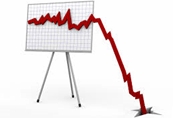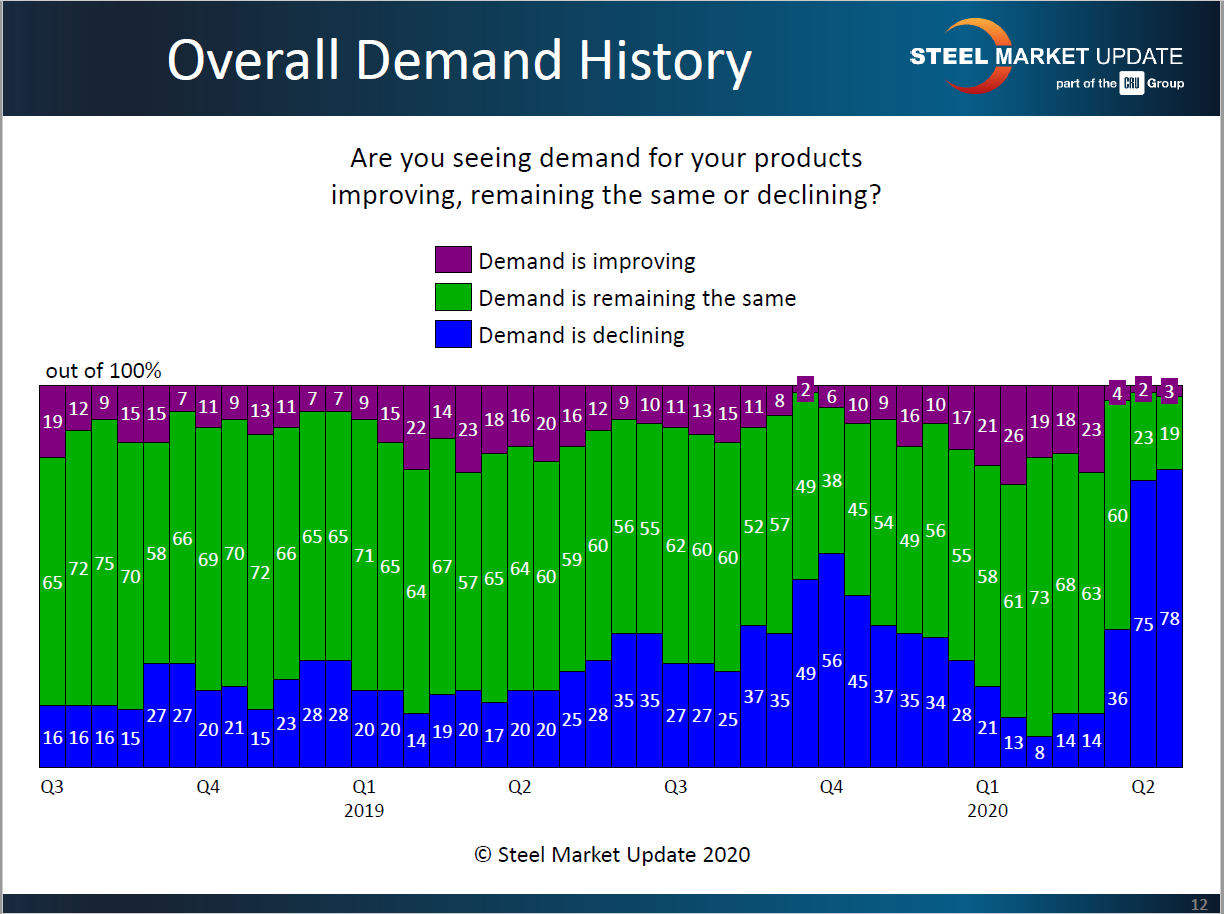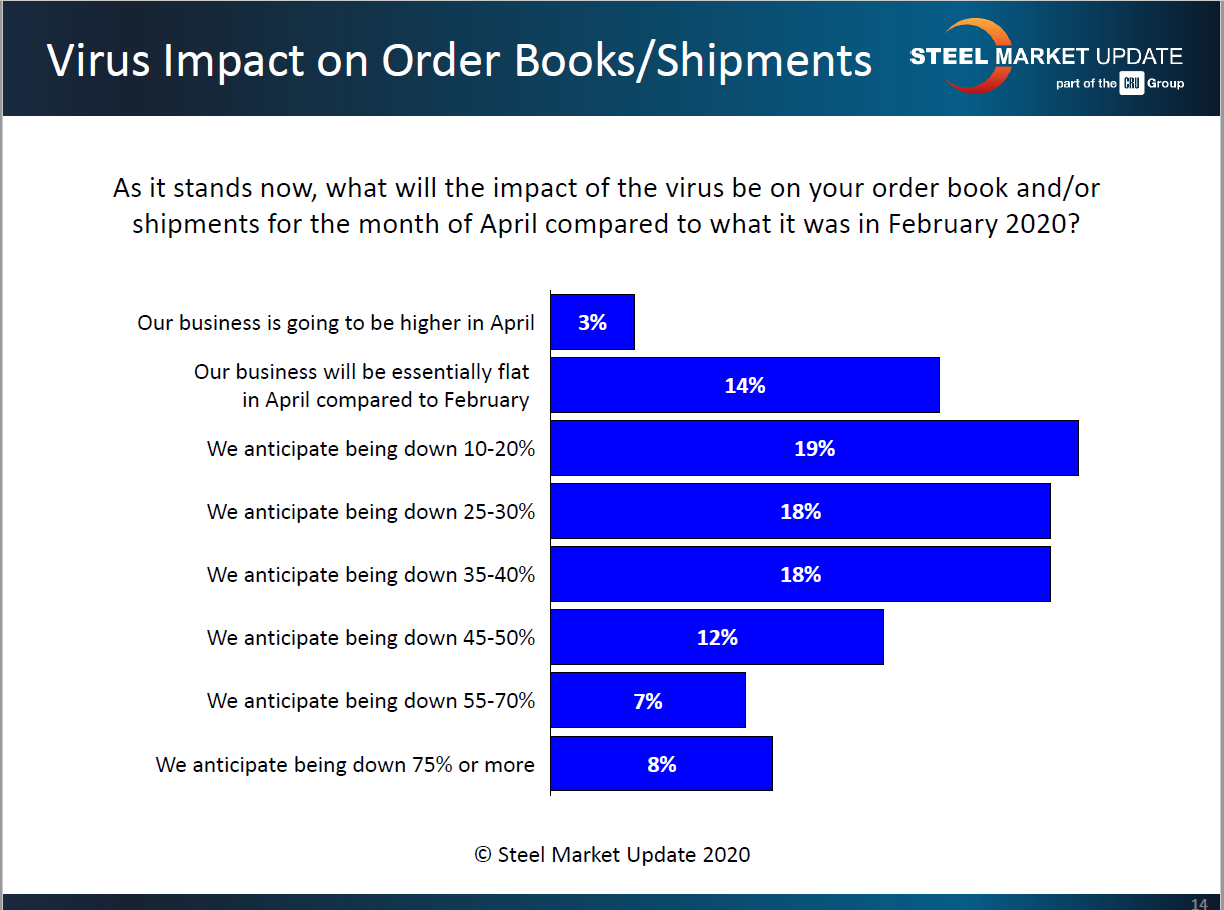SMU Data and Models

SMU Survey: Steel Industry Demand Destruction
Written by John Packard
April 19, 2020
Last week, Steel Market Update conducted an analysis of the flat rolled and plate steel markets as we reached out to more than 500 individuals uniquely qualified to provide insights into these markets. What we found is an almost universal picture of a steel economy in a tailspin.
Through our steel survey, SMU has seen buyers and sellers of flat rolled and plate steels reporting declining demand in their business. Last week, 78 percent of the respondents reported demand as declining (see graphic below).
The past few weeks have seen businesses shift from being “optimistic,” according to our SMU Steel Buyers Sentiment Index, which was reporting sentiment at +58 just six weeks ago. The latest sentiment index reading is -6, a move into the pessimistic segment of our index for the first time since November 2010.
One of the reasons for pessimistic sentiment is the erosion of demand within the industry. During that same six-week period of time, we have seen those responding to our questionnaire reporting declining demand as growing from 14 percent six weeks back to 36 percent four weeks ago, and then to 75 percent two weeks ago, and now the responses have reached 78 percent.
We have been measuring “Overall Demand” (all segment participants in our survey responding to this one question) since Oct. 1, 2012. Prior to this month (April 2020), the second highest decline in demand reported was November 2015 by 40 percent of our respondents. Most months we see reports of declining demand in the single digits to low teens. Our Premium members can view the data here.
How Deep is the Destruction?
We asked the manufacturers, steel distributors, steel mills, trading companies and toll processors participating in our questionnaire what their expectation is on their order books for the month of April compared to the business they saw in February of this year?
Eighty-two percent reported a lower order book in April than February. Here are the results:
Selected Comments Made by Participants During the Survey Process:
“Some sectors have declined significantly while others have actually increased. But overall, demand is down.” This same respondent expected his business to be down 45-50 percent. Automotive service center
“Obviously, business is declining with a significant portion of our customers either closed or only open at drastically reduced production levels.” This respondent expected his business to be down 55-70 percent. Service center
“The past week things changed, and we are seeing a drop. We expect business off about 15 percent for the month” Service center
“Demand has definitely slowed, down about 18 percent.” Wholesaler
ARTICLE CONTINUES BELOW
{loadposition reserved_message}
“The outlook looks very negative as most economists are calling for recession and reduced demand. It depends on how long this lockdown lasts and how quickly any recovery can return. But this year looks not very promising.” This respondent went on to say, “Most buys are for projects that are still occurring with zero for inventory speculation. Even replacement for inventory sold is limited and buyers will trade between divisions before buying from mills.” Then this respondent spoke about their customers’ demand, “While many customers are claiming being off 20-25 percent, I am not clear this is actually true or not overall. Some manufacturing accounts are actually higher now; it depends on the industry. But I think April will be a slow month overall.” This respondent expected business to be down 45-50 percent.
A manufacturer said, “Our dealers will be backed up when we return to work and they are not getting new leads/sales right now.” This respondent reported they cannot get back the work they lost in March. They expect business to be down 55-70 percent.
Another manufacturing company reported, “Tornadoes will cause demand for roll off containers to improve.” Their expectation is for a flat month (no loss of demand in their order books).
A service center executive said, “April and May will be extremely difficult, after that it’s really hard to estimate, but we think the recovery will be gradual and uneven.” This respondent expected business to be down 25-30 percent.
A steel mill executive told SMU, “Some projects are moving out – nothing cancelling.” This respondent expected business to be essentially flat for the month of April.

John Packard
Read more from John PackardLatest in SMU Data and Models

SMU Scrap Survey: Sentiment Indices rise
Both current and future scrap sentiment jumped this month, though survey participants reported responses before key trade news was announced.

SMU Survey: Sentiment splits, buyers have better view of future than the present
SMU’s Steel Buyers’ Sentiment Indices moved in opposite directions this week. After rebounding from a near five-year low in late June, Current Sentiment slipped again. At the same time, Future Sentiment climbed to a four-month high. Both indices continue to show optimism among buyers about their company’s chances for success, but suggest there is less confidence in that optimism than earlier in the year.

SMU scrap market survey results now available
SMU’s ferrous scrap market survey results are now available on our website to all premium members. After logging in at steelmarketupdate.com, visit the pricing and analysis tab and look under the “survey results” section for “ferrous scrap survey” results. Past scrap survey results are also available under that selection. If you need help accessing the survey results […]

SMU flat-rolled market survey results now available
SMU’s latest steel buyers market survey results are now available on our website to all premium members. After logging in at steelmarketupdate.com, visit the pricing and analysis tab and look under the “survey results” section for “latest survey results.” Past survey results are also available under that selection. If you need help accessing the survey results, or if […]

SMU Survey: Sheet lead times stabilize, plate contracts
Mill lead times for sheet products were steady to slightly longer this week compared to our late June market check, while plate lead times contracted, according to steel buyers responding to this week’s market survey.


